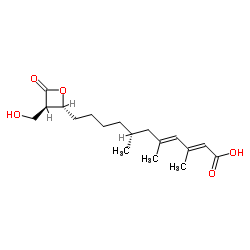Isopentenoid synthesis in eukaryotic cells. An initiating role for post-translational control of 3-hydroxy-3-methylglutaryl coenzyme A reductase.
M D Giron, C M Havel, J A Watson
Index: Arch. Biochem. Biophys. 302(1) , 265-71, (1993)
Full Text: HTML
Abstract
Using insect (Drosophila) and rodent mammalian cell cultures we demonstrate that acute mevalonate-mediated suppression of 3-hydroxy-3-methylglutaryl coenzyme A was initiated in the absence of protein synthesis. In addition, insect and mammalian cells depleted (1 h) of putative regulatory post-isopentenyl-1-pyrophosphate metabolites by incubation with an inhibitor of 3-hydroxy-3-methylglutaryl coenzyme A synthase (L-659,699) accumulated 3-hydroxy-3-methylglutaryl coenzyme A reductase enzyme units. This accumulation resulted primarily from a decrease in the loss of 3-hydroxy-3-methylglutaryl coenzyme A reductase enzyme units rather than from an increase in enzyme synthesis. These observations suggest that the initial phase of mevalonate-mediated suppression of 3-hydroxy-3-methylglutaryl coenzyme A reductase activity was governed primarily by post-translational processes. An unknown rapidly turning over post-isopentenyl-1-pyrophosphate metabolite(s) is proposed as the agonist for these post-translational processes.
Related Compounds
| Structure | Name/CAS No. | Molecular Formula | Articles |
|---|---|---|---|
 |
hymeglusin
CAS:29066-42-0 |
C18H28O5 |
|
Characterization of peroxisomal 3-hydroxy-3-methylglutaryl c...
2000-01-11 [Biochemistry 39(1) , 237-47, (2000)] |
|
Binding site for fungal beta-lactone hymeglusin on cytosolic...
2004-02-27 [Biochim. Biophys. Acta 1636(1) , 22-8, (2004)] |
|
Biosynthesis of antibiotic 1233A (F-244) and preparation of ...
1992-04-01 [J. Antibiot. 45(4) , 563-7, (1992)] |
|
Inhibition of 3-hydroxy-3-methylglutaryl coenzyme A synthase...
1990-06-15 [Biochem. Biophys. Res. Commun. 169(2) , 610-6, (1990)] |
|
Inhibition of hepatic cholesterol biosynthesis by a 3-hydrox...
1993-01-01 [Life Sci. 52(19) , 1595-600, (1993)] |